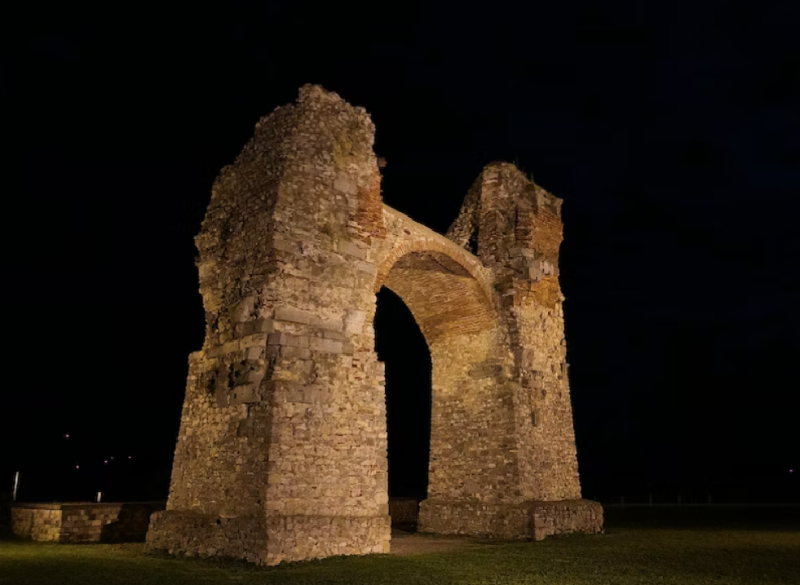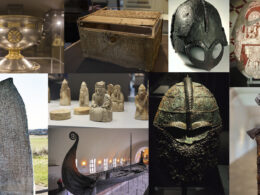Nestled in the picturesque landscapes of present-day Austria lies the captivating ruin known as the Heidentor, or Heathens’ Gate.
Once a magnificent triumphal arch of the Roman Empire, this partially reconstructed structure offers a glimpse into the grandeur of a bygone era.
Situated in Carnuntum, a former Roman fort-city bustling with a population of around 50,000, the Heidentor was believed to have been built during the reign of Emperor Constantius II.
Unveiling the Heidentor’s Origins
The Heidentor, originally constructed as a tetrapylon, featured four arches symbolizing the victories of the local Roman army. Today, only one arch remains, standing as a testament to the passage of time.
Scholars estimate that the Heidentor was erected during the reign of Emperor Constantius II, between 351 and 361 AD. This period marked the height of the Roman Empire’s power and influence.
The tetrapylon design of the Heidentor was a popular architectural style for triumphal arches during this era. Each of the structure’s four facades would have measured approximately 14.5 meters wide, providing a visually striking and symmetrical appearance.
In the center of the monument, a plinth likely held a statue of either a revered deity or a revered emperor, underscoring the Roman penchant for blending religion and politics.
Carnuntum: A Roman City of Significance
To truly appreciate the historical significance of the Heidentor, it is essential to understand the context of its location.
Carnuntum, situated about 900 meters south of the Heidentor, was a thriving Roman city that played a pivotal role in the empire’s military and administrative affairs.
At its peak, Carnuntum boasted a population of around 50,000, including the legionary forces stationed in the vicinity.
This strategic placement allowed the Roman Empire to exert control over the region and safeguard vital trade routes. As an important military and economic hub, Carnuntum was home to significant Roman legions, including the renowned Legio XV Apollinaris.
The city itself encompassed various structures, including public buildings, baths, temples, and an impressive amphitheater, all contributing to the Roman way of life.
Carnuntum’s prominence extended beyond its military and administrative functions; it served as a cultural and social center where diverse influences converged.
Rediscovering the Heidentor
Although the Heidentor stands today as a partially reconstructed ruin, it continues to captivate visitors with its historical and architectural allure.
Its location, just outside the bustling urban core of Carnuntum, allows visitors to immerse themselves in the splendor of ancient Rome while experiencing the tranquil beauty of the surrounding countryside.
The surviving arch of the Heidentor, with its intricate stone carvings and imposing presence, offers a glimpse into the engineering marvels of the Roman Empire.
It serves as a reminder of the grand triumphs celebrated by the local army, immortalized through this architectural masterpiece.
As visitors approach the Heidentor, they can envision the once-thriving city and the legionary forces that defended its borders.
Exploring the ruins of Carnuntum and the Heidentor offers an opportunity to delve into the rich history of the Roman Empire and its enduring legacy.
Guided tours provide insightful narratives, unveiling the stories of ancient emperors, legions, and the daily lives of the people who called Carnuntum home.
In recent years, efforts have been made to preserve and protect the Heidentor and its surroundings. Conservation initiatives and ongoing archaeological excavations ensure that future generations can continue to marvel at this remarkable piece of history.
Summary
The Heidentor, also known as the Heathens’ Gate or Pagans’ Gate, serves as a remarkable link to the past, allowing us to unravel the stories of the Roman Empire and the city of Carnuntum.
This partially reconstructed ruin reminds us of the grandeur and achievements of a civilization that shaped the course of history.
As visitors stand before the remaining arch, they can feel the echoes of the past and appreciate the artistry and vision that brought this triumphal arch to life.
The Heidentor is not merely a ruin but a gateway to a world long gone, beckoning us to explore and appreciate our shared human heritage.
**Please note that this post may contain affiliate links. When booking through one of our links, we earn a small kickback at no extra cost to you and it’s a big help to keep the site up and running.









